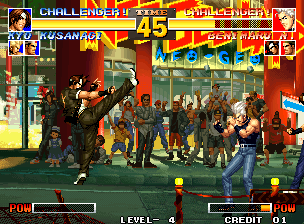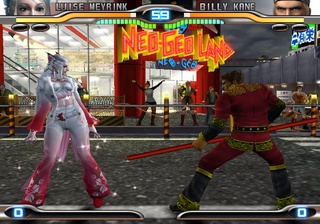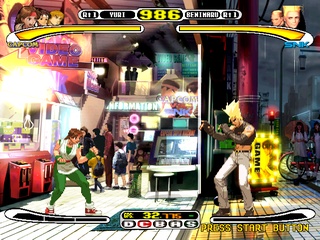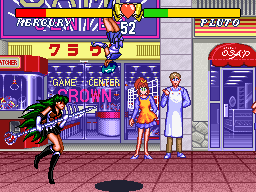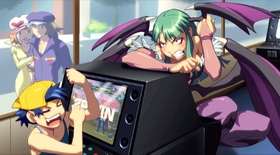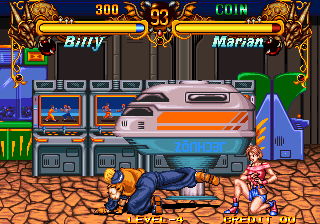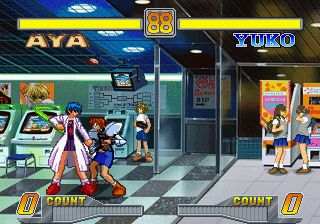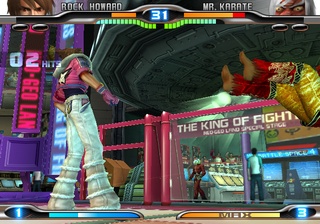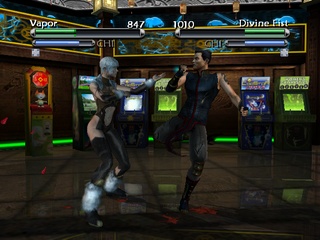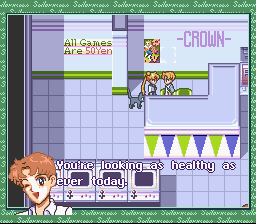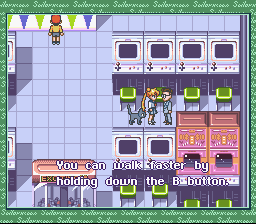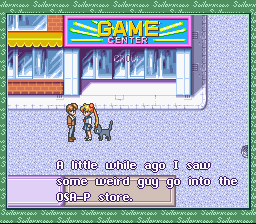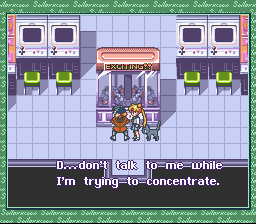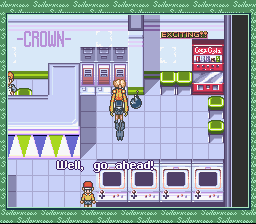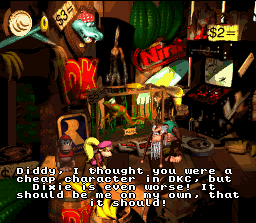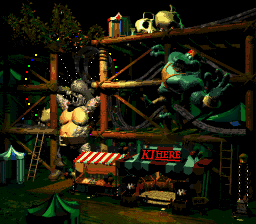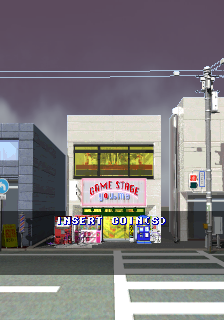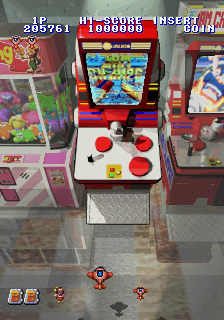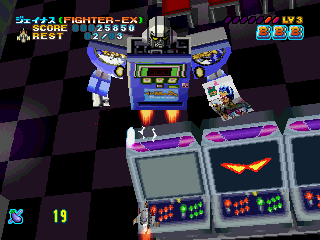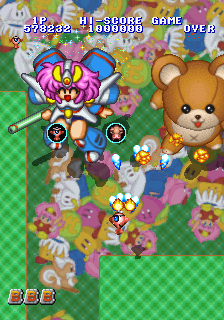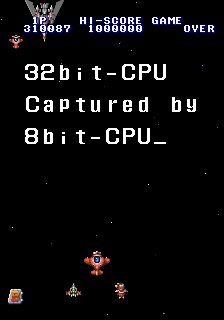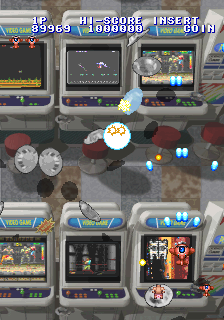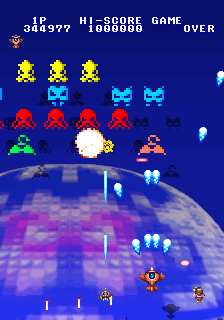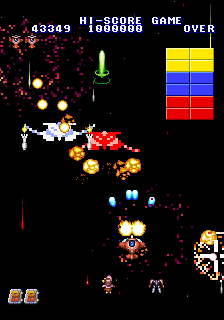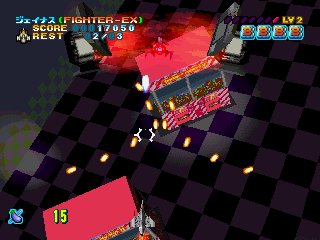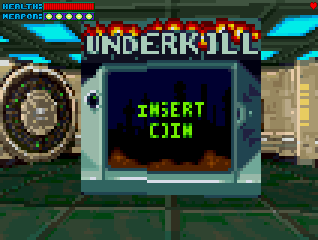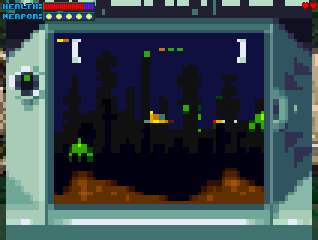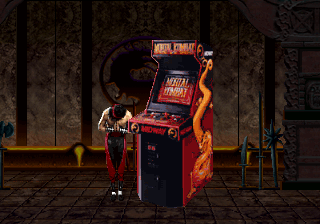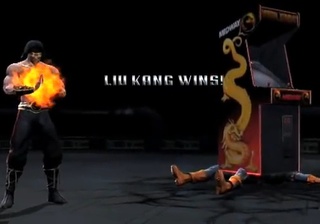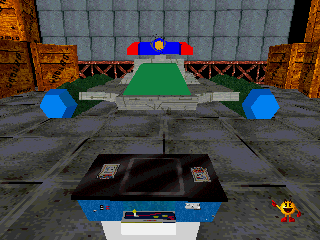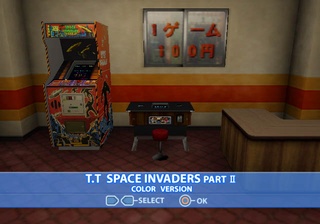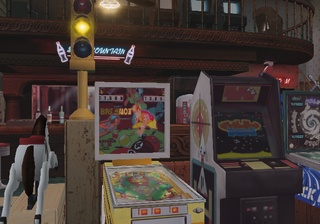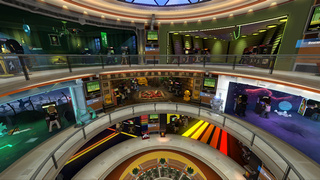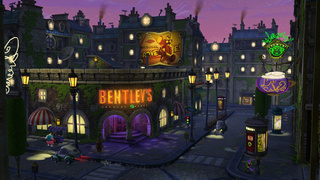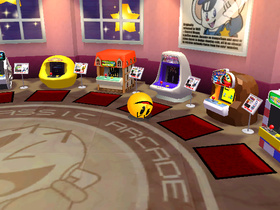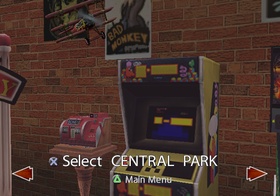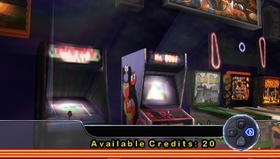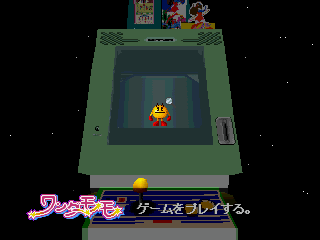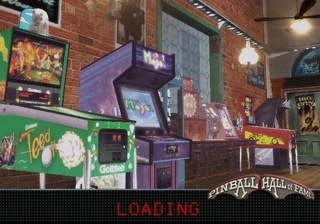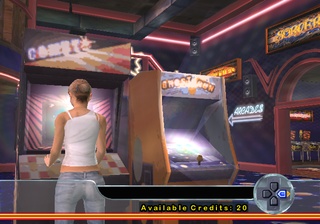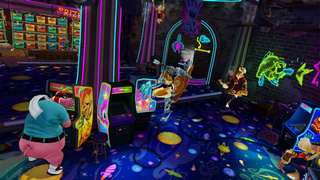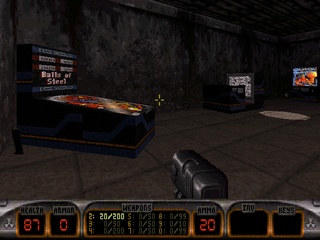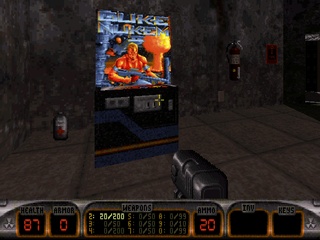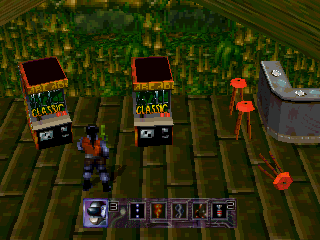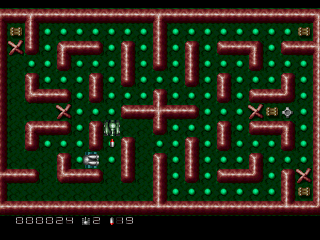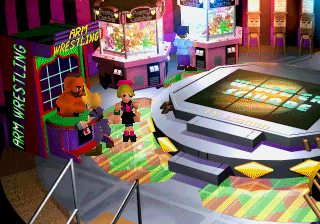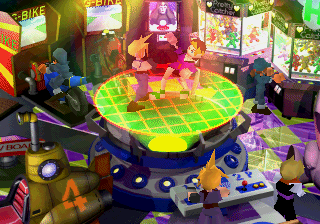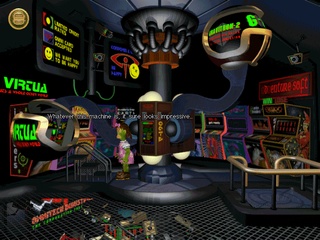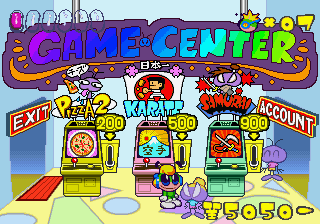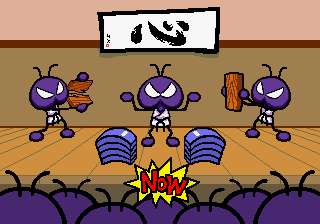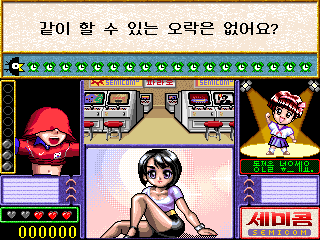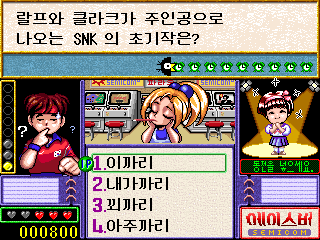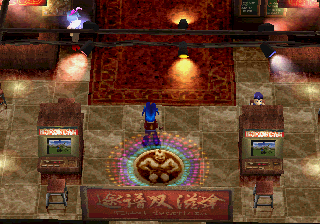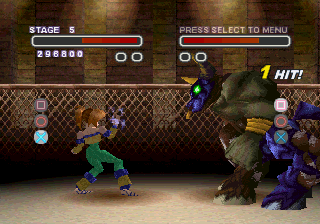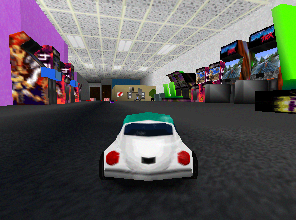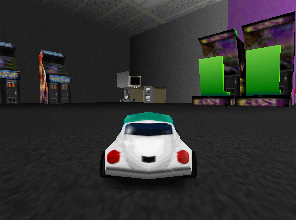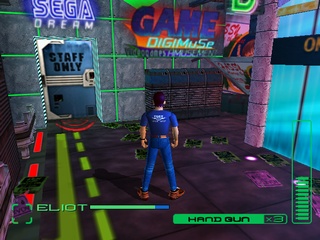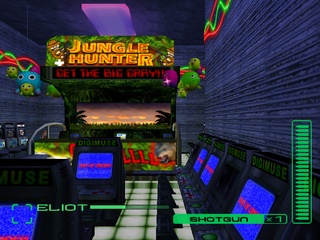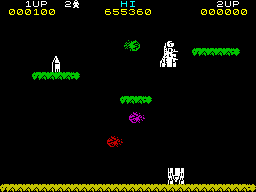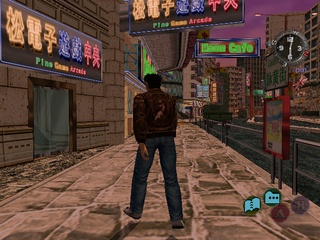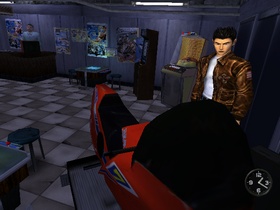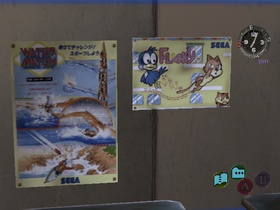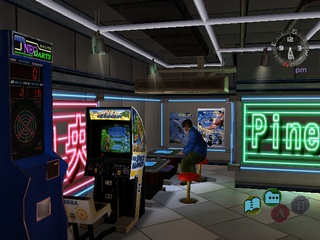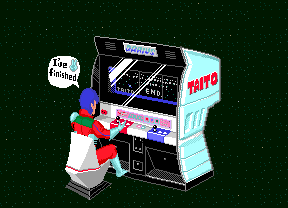
Inventories: Arcades in Video Games
Fighting game stages
Bishōjo Senshi Sailor Moon S (3DO)
The King of Fighters 95 (Neo Geo)
KOF Maximum Impact 2 (PlayStation 2)
Capcom vs SNK (Dreamcast)
While not as frequent as beat-em-ups, there have been a few stages in fighting games that take place in or around arcades, too. In Bishōjo Senshi Sailor Moon S we get to see Game Center Crown again. The Super Famicom version only features a look from the outside, but the 3DO port takes the fighting indoors, with a pretty good look on the "Sailor V" game running on the cabinet screens.
The King of Fighters first included a stage in front of Neo Geo World in the 1995 iteration, and you can vaguely make out an arcade machine through the windows. The second Maximum Impact game (misleadingly titled The King of Fighters 2006 in the US) revisits this stage and even has a variant for fighting inside. It looks more like an amusement park than a game center, but you can spot a few arcade machines in the far background, and there might even be some carboard SNK characters in front of them.
Bishōjo Senshi Sailor Moon S (Super Famicom)
The Double Dragon fighting game for Neo Geo hardware on the other hand pays a visit to a fully furnished arcade, with UFO catchers, a destructible capsule that looks like one of those virtual hydraulic 3D rides, a huge screen that shows clips from the live action movie, and a bunch of arcade cabinets that are not labeled but show a fighting game in action.
The super obscure Saturn fighter Sokko Seitokai Sonic Council by Banpresto has some generic Astro City style cabinets in an interesting stage that is part outdoors, part in the entry area of an arcade. At the turn of the millennium, Capcom vs. SNK did something very similar, only shifting the frame a bit more towards the outside. Close up, you only see an UFO catcher and another redemption game labeled "Capcom Super Machine", but in the back there's something vaguely looking like a rhythm game setup with large speakers.
Tao Feng: Fist of the Lotus also features an arcade stage with a lot of different titles that actually have gameplay screen texures, albeit these are not animated and not very detailed; a golf game "Grass Hole 2003" an early-'80s style maze or platform type game "Simplax Herbi", "Women's Gymnastic Trivia", the harder to identify "Copstar 2094" and "Tsui Nami", alongside a bunch of pinball tables. All of the machines get destroyed with bright sparks when a combatant is smashed into them.
Not a stage in the game, but a location seen in one of the endings can be found in Tatsunoko vs Capcom. In Morrigan's ending, she is seen saying highly suggestive things to a minor, before it is revealed in the next image that she was actually losing against him in a fighting game, while two passers-by look at them with shocked faces as if they actually were engaged in unholy sexual acts.
Tatsunoko vs Capcom (Wii)
Bishōjo Senshi Sailor Moon: Another Story (1995)
Sailor Moon: Another Story (Super Famicom)
In the sole Sailor Moon RPG, Usagi Tsukino finally gets to stroll around Game Center Crown at leisure, disturbing a desperate guy at the UFO catcher and getting tutorial info from a bunch of other players. Unfortunately, she still can't play "Sailor V" and the only exciting thing about the interior is the lettering on the walls literally proclaiming "EXCITING!"
(images taken from Gragt's Let's Play on the RPG Codex Forums.)
Donkey Kong Country 2 (1995)
In this installment, Cranky Kong is selling a worn old arcade machine for $2 in his Monkey Museum (next to a bunch of SNES carts and a huge SNES joypad, strangely). At the side, it is labeled "KI", in reference to Rare's fighting game Killer Instinct. Its position on the map screen of Krazy Kremland is depicted as a tent with a banner saying "KI here" and some tiny weeny arcade machines at the front.
Game Tengoku series (1995-1998)
The Game Paradise! (Arcade)
The Game Paradise! (Arcade)
The Game Paradise! (Arcade)
The Game Paradise! (Arcade)
Gunbare! Game Tengoku 2 (PlayStation)
This shoot-em-up by Jaleco takes place entirely within an arcade, the "Game Stage You & Me", which is attacked by a mysterious villain sporting a thorougly twirl-worthy mustache. The first stage has one (or two) of the four heroes flying across lots of generic cabinets with games running on them, before the journey goes on over a huge pinball table and through the plush toy compartment of an UFO catcher.
The Game Paradise! (Arcade)
The next few stages lead you through typical shoot-em-up and racing game worlds, but you're still attacked by guys in appropriate sit-down cabinets throughout. Then the game puts out the message "32bit-CPU Captured by 8bit-CPU", and attacking ships turn into Galaxian enemies. The demake area further comprises parodies of Space Invaders, Head-On and Breakout.
The Game Paradise! (Arcade)
In the final stage, task windows of creation tools and unfinished 3D models pop up for some reason, followed by a bomb raid on the chips of a circuit board. The Game Paradise is a truly wacky game - in the end, you even get to shoot down the letters of the staff credits and a big "THE END" (and you're awarded points for them), before the stages loop from the beginning.
The Game Paradise! (Arcade)
The PlayStation-exclusive sequel Gunbare! Game Tengoku 2 (PlayStation) follows the same theme but makes the jump to 3D, which means that the arcade is much less detailed, with nothing but a pair of evil eyes on the cabinet monitors. It's also only the first stage that takes place within an arcade - the second starts out in a living room, before a console sucks you into the TV screen. You still get to fight bosses like Tamagotchi style device, where you have to shoot the buttons to evolve the creature within until it dies of old age, but everything beyond that just takes place directly in game worlds, with no clear reference to arcade hardware.
Gloom (1995)
Gloom wears on its sleeve what it wants to be - proof that Doom can be done on the Amiga. Some parts of it are less successful at this than others, but it pioneers in one area where Doom only caught up almost a decade later: A smooth depiction of a functional screen display within the game's engine without transition. In an early stage, you can find a hidden area, which houses the arcade game "Underkill". The gameplay is similar to Defender, but there is no one to rescue here, only aliens to shoot. Surviving the wave of enemies is rewarded with an extra life for the main game.
Mortal Kombat series (1995-2008)
While there is no joy and therefore no arcades in the Netherrealm, by the third game Liu Kang has learned to always bring a Mortal Kombat machine with him - to squish his opponents under with a fatality. Nightwolf also summons a Mortal Kombat II machine in his Friendship move in Ultimate Mortal Kombat 3, while transforming himself into Raiden. The move was phased out when the series made its transition to 3D, but made a return when Midway was in need of PG-13 compatible fatalities for Mortal Kombat vs DC Universe.
Ultimate Mortal Kombat 3 (Arcade)
Virtual arcades as menus
Namco Museum Vol. 2 (PlayStation)
Space Invaders Anniversary (PlayStation 2)
Pinball Hall of Fame: The Gottlieb Collection (PS2)
Pinball Hall of Fame: The Williams Collection (PS2)
Game Room
PlayStation Home (Playstation 3)
Bentley's Hack Pack (Playstation 3)
Star Wars Rogue Squadron III: Rebel Strike (GameCube)
What could be a more self-suggesting menu for an arcade game compilation than a virtual game room? Technically this started with the C64 budget compilation Arcade Classics, where you'd select one of four arcade game clones on a menu screen of arcade machines, but the concept was first fully realized with the Namco Museum series. True to the title, these drop you in a virtual museum with lots of exhibits related to the featured games, of course including a model of the original cabinet, which you can walk up to and play. Namco Museum Encore has the most machines from that era, but here they are just floating in outer space. Namco abandoned the approach in many of the later titles, but Namco Museum Remix for the Wii has an arcade where all the original versions are available, while the remixes take place in amusement park style standalone attractions. Taito's Space Invaders Anniversary collection also takes place in an Invader Room full of neatly arranged machines of the classic's various versions. More recently, Midway Arcade on the iOS App Store follows a similar template.
Namco Museum Remix (Wii)
Pinball Hall of Fame: The Gottlieb Collection is a compilation of pinball tables that are also selected from a virtual arcade. In between the pinball tables are various other amusement machines as decoration, including arcade cabinets that are very obviously based on Missile Command, Asteroids and Q*bert, but with all the titles replaced by unintelligible graphical elements (Q*bert was actually a Gottlieb game, but the rights for it went to Columbia). There is also a machine labeled "Mojo!", which was a puzzle game for PlayStation 2 and Xbox by the same publisher/developer combo, Crave Entertainment and FarSight Studios. Maybe there were some legal issues with the all too obvious imitations of trademarked arcade machines, as all of them were removed from the later PSP and Wii versions.
Pinball Hall of Fame: The Gottlieb Collection (PS2)
That didn't hinder The Williams Collection to include arcades again in all version, although the references are a little less obvious. Many machines are still clearly recognizable, such as the Tron arcade game under the guise of "Cyber", a more loose variation on Q*Bert called "Mr. Cube", another Missile Command lookalike named "Rocket Attack", "Worm" in place of Centipede, "Ghost Run", whose screen resembles the maze from Pac-Man, and many, many more. The interior with its two-floor setup and a bar in the back is based on a real location, Ground Kontrol in Portland, OR.
Pinball Hall of Fame: The Williams Collection (PSP)
Sony's ill-fated Second Life style chatroom Home also included an arcade area, where a number of exclusive games could be played. Home is scheduled for a shutdown soon, but the arcade part alone is also available as a standalone app for PSVita.
Also not terribly successful due to its early focus on extremely old games was Microsoft's Game Room, a three-story virtual arcade developed by Krome Studios. Curiously, it also offered console games from the Atari 2600 and Intellivision era, which were still presented as arcade cabinets - with the respective console mounted on top.
Smaller in scope was Bentley's Hack Pack, a spin-off expanding on the hacking mini games from the Sly Cooper series. It only features three playable games, but you still can look around the room and see characters from the series play faux ancient 8-bit stuff.
Even though it is not a game compilation, Star Wars Rogue Squadron III: Rebel Strike allows unlocking the classic Star Wars arcade game trilogy either via secret codes or by completing specific missions. This adds a new menu that takes you to a hangar as Darth Vader, where you can walk up to the machines and select them as you'd select vehicles in the virtual hangar of the main game. Similarly, Project Gotham Racing 3 has two playable Geometry Wars cabinets in the virtual garage menu. The older Flight Unlimited features an arcade machine in its walkable 3D menu as well, but here it isn't playable.
Zwei! 2 (Windows)
A slightly different application can be found in Falcom's Zwei! 2, where arcade machines represent boss selections in a boss rush room. Dust Force also has a similarly-styled level select feature.
Namco Museum Encore (PlayStation)
Space Invaders Anniversary (PlayStation 2)
Pinball Hall of Fame: The Gottlieb Collection (PS2)
Pinball Hall of Fame: The Williams Collection (PS2)
Game Room
PlayStation Home Arcade (Playstation Vita)
Bentley's Hack Pack (Playstation 3)
Star Wars Rogue Squadron III: Rebel Strike (GameCube)
Duke Nukem 3D (1996)
The area in the first stage of Duke Nukem 3D is no doubt one of the most famous arcades inside a game, even though no machine is playable. If the player tries to interact with the Duke Nukem II cabinet, Duke proclaims: "I don't have time to play with myself." The room is also home to a nameless sit-down cabinet, whose screen only shows static, and the "Balls of Steel" pinball table, which returns in playable form in Duke Nukem Forever, although in a strip club instead of an arcade.
Toonstruck (1996)
Cutopia's arcade is just as distorted as the rest of the Toonstruck world, but somehow the machines are functional in spite of their shape. However, two out of three are always occupied by unlicensed Carebear cameos. Only "Wacman", the game in the center, is free for Christopher Lloyd as Drew Blanc to play. In it, two caveman-style warriors throw shuriken at each other, which they can deflect with their shields.
Contra: Legacy of War (1996)
The 3D rendition of Contra is widely known as one of the low points of the series. Less widely known - because most players couldn't be bothered to hold out until the second stage - is the little jungle arcade it is home to. The establishment only has two machines labeled as "Arcade Classic", but both of them are playable and actually different games. The first is a clone of Konami's own Gyruss, the other a tank maze action game similar to Namco's Tank Batallion. Fortunately you don't actually have to play Legacy of War to see them - they can also be accessed via cheat codes.
Final Fantasy VII (1997)
One of the many attractions Cloud Strife and crew get to visit in the enormous amusement park Gold Saucer is Wonder Square, one of the biggest and most interactive arcade areas in a game ever. Here, you can replay the motorbike, snowboard and submarine mini games from the story, alongside a lot of unique games: There's a virtual armwrestling machine, basketball hoops, a holographic fighting game (which is essentially just rock-paper-scissors) and "Mog House", where you take care of one of those cute moogles. Gold Saucer returns in different form in Final Fantasy XIV, but all its arcade games (so far) are recreations of mechanical games.
The Feeble Files (1997)
The Feeble Files arcade is a little infamous among old school adventure players (or at least among the few who actually know this mediocre title), because it forces you to play a whole bunch of inane logic puzzles with a Simon the Sorcerer theme - over and over again, as you need the tokens gained from them for a super annoying UFO catcher crane game.
Super Tempo (1998)
Tempo is a largely forgotten series of music-themed mascot platformers Sega put out in the mid-nineties, and Super Tempo is the least known of them due to being a late Saturn title released exclusively in Japan. One of its stages is a small game center, where you can invest money in three micro games with very generic names - "Karate", "Samurai" and "Pizza 2". The games are actually much funnier than the titles suggest.
Date Quiz Go Go (1998)
In this Korean quiz/board/dating game, you roll the dice to determine the next location for your date with one of three hot girls, and one of the possible destinations happens to be an arcade. Because this is also a quiz game, your love interest then starts to check your game related knowledge, from broad questions like "Which of these is not a computer storage medium?" to really specific stuff such as "What early SNK game did Ralph and Clark star in?" Oh if only there was a world where video game trivia knowledge resulted in dating success...
Legend of Legaia (1998)
Legend of Legaia is essentially Sony's attempt to nab a piece of the sweet, sweet Final Fantasy VII pie, so some parallels to that game are not surprising. Sol Tower could be described as a poor man's Gold Saucer, featuring various amusement opportunities. The Muscle Dome is dedicated to arena matches, but in its entrance arena, there are two arcade machines with the game "Baka Fighter". In Japanese, that means "Stupid Fighter", and the game is pretty stupid. It's styled like a fighting game where you can choose between the three main characters and fight various monsters from the game, but it only consists of rock-paper-scissor type matches where you press one of three buttons and watch whether your choice beats the opponent's to chip away a chunk of their health. The first few enemies almost always do the same action, but they continuously grow stronger and more randomized as you beat them.
Rush 2: Extreme Racing USA (1998)
If you win a complete circuit of 28 tracks in Midway's arcade fun racer, you get to unlock a giant sized replica of the Midway office building to race through. While not precisely an amusement venue, it's still full with arcade machines of the company's most recent titles. The games on display are Gauntlet Legends, Area 51: Site 4, Vapor TRX and the direct predecessor San Francisco Rush: Extreme Racing - although the mushy textures ensure that only the "Rush" part is actually readable.
Blue Stinger (1999)
Although the company was known for their cheesy horror, the late Shinya Nishigaki's Crazy Games was a very game meta friendly joint, as both of their major titles contain a bunch of references. Along references like collecting coins from defeated enemies (which fling around suspiciously similar to Sonic's rings), Blue Stinger, the heart-warming Christmas tale on an island overrun by ghastly parasites that turn humans into bloodthirsty monsters, also features a game center. "GAME DIGIMuSe" openly betrays the developer's close partnership with Sega right on the front door. Unfortunately, all of the generic cabinets inside are out of order, and neither the pachislots nor the pinball tables are interactive, either. The only thing you can "play" is the big "Jungle Hunter" shooting gallery, where all it takes is destroying three cardboard animals with your real gun to win a Big Gary plush toy. (Which of course you couldn't have just plucked from the ceiling to give to the little girl in the corner).
Jet Force Gemini (1999)
Jet Force Gemini may be Rare's most low profile Nintendo 64 title, but that didn't stop them from hiding an entire disco for the evil ants in there. In a side room there are two arcade machines, which actually have to be operated with tokens that can be found around the area. The games are "Jeff & Barry Racing" and "Jeff & Barry Racing II". Both are basically the same overhead single screen racing game, only with a different circuit in each of the two.
Donkey Kong 64 (1999)
More arcades for Donkey Kong, but in this case, it's actually playable. In the factory stage, Donkey Kong can activate a machine of his own very first game (or rather his grandfather's, as per retconned Donkey Kong Country canon). Oddly, it is started by pulling a huge lever. When playing through the arcade classic's four stages once, Donkey receives a golden banana. It's also possible to play through it a second time, this time with Pauline replaced by a N64 logo coin, which is the prize for the second playthrough. It's actually kind of significant - this is the only time Nintendo ever put out a faithful adaption of the original arcade game on a home console, as the later Virtual Console release is just the shortened NES version.
In the next stage, the apes get access to Jetpac, the Stamper brothers' first Spectrum game. However, it is appropriately played on an old computer in Cranky's lab. Beating it yields the Rare coin, and both the Nintendo and Rare coins are mandatory to reach the final boss.
Shenmue series (1999-2001)
Even though the series crashed before it could be completed and maybe it wasn't all that great as a game, Shenmue will always hold a place in the hearts of its fans - among many other reasons, for its incredibly believable, fully functional arcade (aside from one broken machine and two rudimentary cocktail cabinets where sometimes gangsters would sit and play, with a screen display vaguely resembling Deep Scan). It was magnificent. Arcade perfect renditions of Space Harrier and Hang-On, a playable dart board and two variants of period-appropriately dressed QTE practice machines sure seemed like a lot to squeeze into an ingame arcade in 1999.
Shenmue (Dreamcast)
The much more adventurous sequel features even two more of Yu Suzuki's old games, OutRun and After Burner. Only Space Harrier and OutRun (and a few of the smaller games) are available at the local Pine Arcade in Hong Kong's Golden Quarter, though. After Burner and Hang-On have to be found in hidden locations in Kowloon.
Shenmue 2 (Dreamcast)
Both arcades also have flyers for some less famous Sega classics that Ryu cannot play, including Future Spy, Flicky, Fantasy Zone and Water Match.

